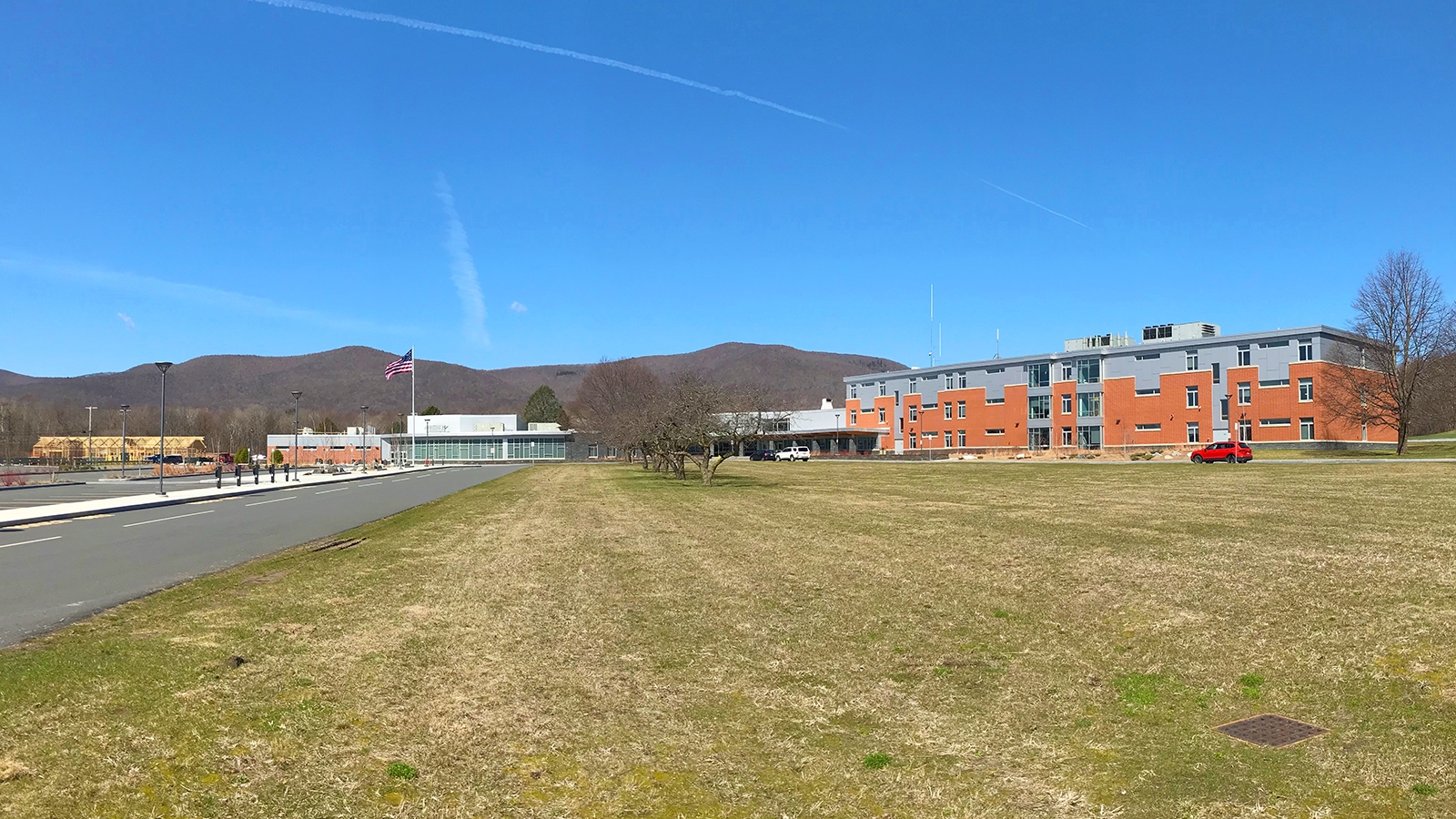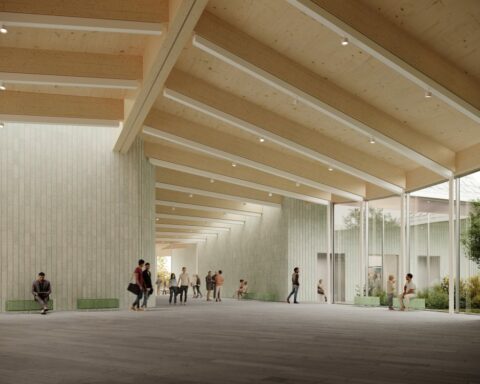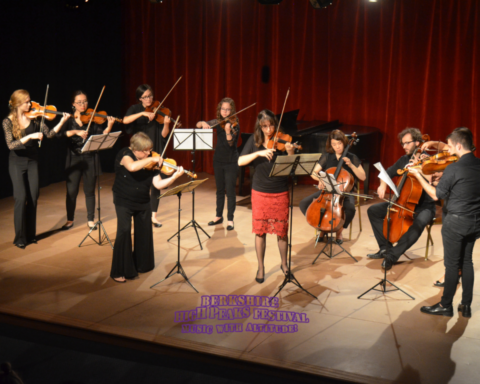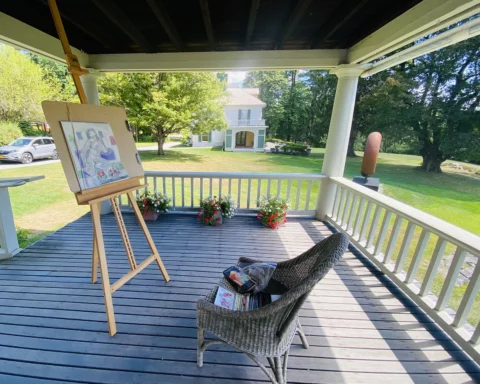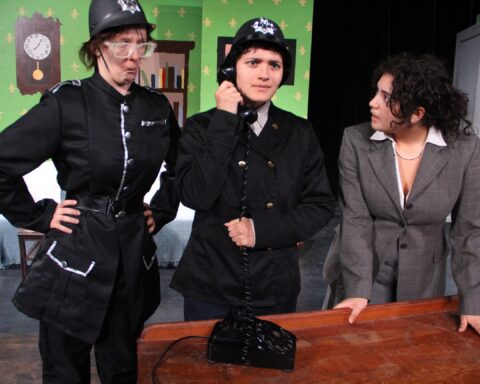ABOVE: Mount Greylock Regional School, Williamstown, Mass. — April 7, 2020; photo by Jason Velázquez.
WILLIAMSTOWN, Mass — 18-year-old Sophie Coyne has to get out of the house periodically during the school year because, like many high school students, she has a hard time focusing on schoolwork in the confines of her home.
“I have a younger brother who doesn’t like to respect my privacy or my time,” Coyne said. “He’ll sit in the room next to me and blare ‘South Park.’ You really can’t focus on anything else when that is in the background.”
Now, Coyne faces a new challenge — managing a full-time high school education from a house in which “there is no respect” for the learning she’s doing. According to Coyne, the remote learning experience brought on by COVID-19 and the subsequent closure of Massachusetts schools has not been easy.
For weeks, Massachusetts students have been out of school since Governor Charlie Baker declared a first three week, then several month, statewide school closure. For the first few weeks of what students on social media began to call “Coronacation,” schools were only able to assign work for enrichment, not for credit. Now, many districts are transitioning into a structured remote learning model.
In Williamstown and Lanesborough, the result has been a decentralized effort to provide students with educational resources.
“Most of the communications I’ve received have come directly from specific teachers,” Mt. Greylock student Molly Howard said. “I’ve received almost zero centralized information from the school regarding actual educational steps.”
For many districts, including Mt. Greylock, part of the challenge of creating momentum comes with completing bargaining processes with teacher unions to finalize remote learning plans. Some districts have developed loose, relatively unstructured plans like Mt. Greylock, which for weeks has filtered most educational resources through an enrichment page on the school website.
Kimberly Grady, Mt. Greylock Regional School District superintendent, said administrators in the district have been working extra hours to create a system that will work for both students and teachers.
“We’ve been fortunate in that we’ve already rolled out one-to-one technology to many grades,” Grady said. “Many of our teachers have been using some form of technological learning for a while now.” Grady said a challenge has been to ensure that all students have access to internet resources, and that the district has investigated the use of cellular hotspots, especially in the case of “weak spots” like Hancock.
While many teachers, according to Grady, are swiftly adjusting to the remote model, North Adams Superintendent Barbara Malkas noted that this is not always the case.
“We have plenty of staff who were really apprehensive,” she said. “They’re older. They’re not digital natives. They’re scared about what these changes mean to the profession they know and love.”
Districts like North Adams also face the task of starting up a remote learning plan while simultaneously supporting a uniquely vulnerable student body. Sixty-seven percent of North Adams students are designated as high-need, and about 25 percent are on Individualized Education Programs (IEPs), meaning that they are eligible for some form of special education.
“Our major priority was to really look at Maslow’s hierarchy of needs,” Malkas said. “Are kids safe? Do they have a safe place to stay? Getting lunch services up and running was the first priority.”
As for special education, Malkas said working to provide students with the necessary resources in such a crisis meant “pushing the envelope.”
“If you had asked me about a month ago, would we be where we are, where we’re thinking about how to provide these services in this situation, I would have said it couldn’t be done,” Malkas said.
In North Adams, all school adjustment counselors are hooked up with access to a school phone in their house, so they can reach students on their caseloads. Education specialists like occupational, speech, and physical therapists have been able to get online with students. And according to Malkas, academic support services are being treated “like a regular classroom.”
“It’s not going to be perfect,” she said. “But it’s going to be better than not having services.”
On the other side of what Malkas said have been 14 to 16 hour days for administrators is the often just-as-confusing world of learning during a pandemic — a student experience shaped by “not knowing what’s going on,” “being scared,” and “not doing much,” according to several students who spoke to the Glass.
While schools like Mt. Greylock are working toward flexible learning programs, Coyne’s high school has launched a 9 to 3 daily school schedule. Students follow a pretty typical block format, with hour long classes separated by thirty-minute breaks and a lunch period mid-day. Wednesdays are reserved for debrief meetings with teachers.
“When we meet for that hour, we’re not getting work done, so then our teachers are assigning work on top of that,” Coyne said. “We end up having a ton of work to do, and the meetings with teachers don’t tend to end up being very useful because it’s mostly just us trying to talk to humans again. It’s been really tough to get my work done because it keeps building up.”
Coyne’s rigid academic format stands in stark contrast to Greylock’s. Across Western Mass, there is hardly any consistency regarding educational practices.
“Some teachers have reached out with resources, but not much yet,” Greylock student Clara McWeeny said. “There’s a lot of confusion and uncertainty floating around in that regard.”
“Right now I haven’t done much of anything,” Howard said. “Part of that is a lack of motivation and struggling to do work while I’m at home, but then the other part of it is feeling like I don’t have any clarity about what I should be doing. Even for the work that I have gotten, there aren’t due dates. I’m not sure what I’m being asked to do.”
Part of the variance in educational environments may be attributed to where different districts are at in the legal bargaining process. It could also be a result of the various demographic factors that impact a district’s ability to provide services, like North Adams’s high-need student proportion. Instructions given by the Department of Education also remain vague and open for interpretation. They stress that:
“…districts, schools, and communities have an obligation to engage students in meaningful and productive learning opportunities through an appropriately structured educational program…”
and provide several “guidelines” for how to achieve this, but most of how schools react to the switch to remote learning is happening on a district-by-district basis.
And while districts scramble to provide remote learning plans and teachers scramble to provide instruction, many students are struggling to even comprehend their studies in the face of what some of them noted to be the most major crisis they’ve lived through.
“It’s really hard to be sitting down to write this paper that has absolutely no impact on the future while x, y, z is happening,” Coyne said.
Howard also said it’s been hard to find the motivation to get work done when everything in her life is changing.
“But I’m doing OK,” she said. “The key has been to keep myself busy. I’ve sat down at the pottery wheel more lately, and I’ve been trying to get outside when I can. Talking to people helps.”
McWeeny said that in her household, people have been aware of the gravity of the situation, but the siblings have been able to bond over games, and they get to spend time on FaceTime with relatives.
Nico McWeeny, a student at Williamstown Elementary School, said he’s been able to use the time well. “I’ve played a lot of Madden,” he noted.
“This time in history is going to be very difficult,” Malkas said. “We have to let the data speak. We have to let this be a public health issue and not a political one. We need to heed the warnings. We want to be in a place in June where the sun is shining, and the emergency orders are ending, not where the numbers are still climbing.”
